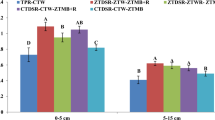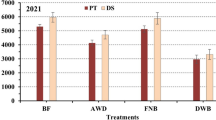Abstract
Traditional upland rice-based cropping systems in West Africa rely on periods of fallow to restore soil fertility and prevent the build-up of insect pests and weeds. Demographic growth and increased demand for land is forcing many farmers to intensify their rice production systems. Declining fallow length and increasing number of crops before leaving the land to extended fallow result in a significant yield reduction. Promising cropping system alternatives include the use of site specific, weed-suppressing, multi-purpose cover legumes as short duration fallows. Constraints to rice production related to intensification were determined in 209 farmers' fields in four agro-ecological zones during 1994 and 1995. Nitrogen accumulation and weed suppression were evaluated in 54 legume accessions, grown for six months during the dry season, under a range of hydrological and soil conditions in 1994/95. Their effect on the yield of upland rice was determined in 1995. To increase benefits from improved fallow technology, the timing of legume establishment in relation to rice and the effect on crop and weed growth of removing, burning, mulching, or incorporating fallow residues prior to the rice crop were determined. Intensified land use resulted in a significant plot-level yield reduction that was highest in the derived savanna and the bimodal forest zones where it was associated with a doubling of the weed biomass in rice and a significant reduction in soil N supply. Legume fallows appear to offer the potential to sustain rice yields under intensified cropping. Legume biomass was in most instances significantly greater than in the weedy fallow control and several legume species suppressed weed growth. Nitrogen accumulation by legumes varied between 1–200 kg N ha-1 with 30–90% Ndfa. Rice grain yield following legume fallows increased by an average of 0.2 mg ha-1 or 29% above the weedy fallow control. Relay establishment substantially increased legume biomass. However, seeding of the legume at 28 days or earlier significantly reduced grain yield due to interspecific competition. Incorporating or mulching of fallow residues provided no significant yield advantage as compared to burning. Absolute effects varied as a function of site, legume species, and management practice.
Similar content being viewed by others
References
Agboola AA & Fayemi AAA (1971) Preliminary trials on the intercropping of maize with different tropical legumes in Western Nigeria. J Agric Sci Camb 77: 219–225
Agboola AA (1994) A recipe for continuous arable crop production in the forest zone of western Nigeria. In: Sanchez PA and van Houten H. (eds) Alternatives to Slash-and-burn Agriculture, pp 107–120. Int Soc Soil Sci and Mex Soc Soil Sci: INEGI, CNA, Mexico
Akobundu IO (1993) Integrated weed management techniques to reduce soil degradation. In: Proc First Int Weed Contr Congress, pp 278–294. Melbourne, Australia
Alegre JC & Cassel DK (1994) Soil physical dynamics under slash-and-burn systems. In: Sanchez PA and van Houten H (eds) Alternatives to Slash-and-burn Agriculture, pp 47–62. Int Soc Soil Sci and Mex Soc Soil Sci: INEGI, CNA, Mexico
Balasubramanian V & Blaise NKA (1993) Short season fallow management for sustainable production in Africa. In: Ragland J and Lal R (eds) Technologies for Sustainable Agriculture in the Tropics, pp 279–293. ASA-Special Publication No. 56. Madison, Wisc: American Society of Agronomy
Balasubramanian V & Sekayange L (1992) Five years of research on improved fallow in the semi-arid highlands of Rwanda. In: Mulongoy K, Gueye M and Spencer DSC (eds) Biological Nitrogen Fixation and Sustainability of Tropical Agriculture, pp 405–422. John Wiley & Sons, Chichester
Becker L & Diallo R (1992) Characterization and classification of rice agro-ecosystems in Côte d'Ivoire. West Africa Rice Development Association, BP 2551, Bouaké, Côte d'Ivoire. 135 pp
Becker M & Assigbe P (1995) Rice-based cropping systems research in West Africa. In: CNRS, CIRAD (eds) Proc Intern Coll ‘Quel avenir pour les rizicultures en Afrique de l'Ouest?’, 4–7 April 1995, Bordeaux, France
Becker M, Johnson DE, Heinrichs EA, Afun K & Russell-Smith A (1995a) Effect of cropping intensification on biotic and abiotic constraints in upland rice. In: CNRS, CIRAD (eds) Proc Int Coll ‘Quel avenir pour les rizicultures en Afrique de l'Ouest?’. 4–7 April 1995, Bordeaux, France
Becker M Ladha JK & Ali M. (1995b) Green manure technology: Potential usage, limitations. A case study for lowland rice. Plant Soil 174: 181–194
Bunch R (1990) The potential of intercropped green manures in third world villager agriculture. Conference on the socio-economics of organic agriculture. IFOAM, Hamstead Marshall, UK
Carangal VR Rebancos Jr E.T Armada EC & Tengco PL (1994) Integration of food, forage, and green manure production systems. In: Ladha JK and Garrity DP (eds) Green Manure Production Systems for Asian Ricelands, pp 51–65. IRRI, PO Box 933, Manila, Philippines
Faulkner OT (1934) Some experiments with leguminous crops at Ibadan, Southern Nigeria, 1925–1933. Empire J Exp Agric. 2: 93–102
Gigou JJ (1992) L'azote dans les systèmes de culture du nord et du centre de la Côte d'Ivoire. In: Mulongoy K, Gueye M and Spencer DSC (eds) Biological Nitrogen Fixation and Sustainability of Tropical Agriculture, pp 377–394. John Wiley & Sons, Chichester
Hartmans EH (1981) Land development and management in tropical Africa. IITA, PMB. 5320, Ibadan, Nigeria
Hauck RD & Weaver RW (1986) Field measurement of dinitrogen fixation and denitrification. SSSA Special Publication No. 18. Madison, Wisc: Soil Science Society of America. 115 pp
Heinrichs EH, Johnson, DE, Afun JK & Robison DJ (1995) Rice pests of shifting cultivation in Côte d'Ivoire, West Africa. In: IRRI (ed) Fragile Lives in Fragile Ecosystems, pp 537–553. Proc Int Rice Res Conf, 13–17 February 1995, Los Baños, Philippines
Hoefsloot H, van der Pol F & Roeleveld L (1993) Jachères améliorées. Options pour le developpement des systèmes de production en Afrique de l'Ouest. KIT Press, Bulletin 333, Amsterdam, The Netherlands. 87 pp
IITA-International Institute for Tropical Agriculture (1993) Improvement of soil fertility and weed suppression through legume-based technologies. Collaborative Group on Maize-based Systems Research (COMBS). IITA Research Guide 48, IITA, PMB. 5320, Ibadan, Nigeria
Johnson DE & Adesina AA (1993) Farmers' perceptions of rice weeds and control methods in Côte d'Ivoire, West Africa. In: Proc. Brighton Crop Prot. Conf, pp 1143–1148. Brighton, UK
Ladha JK & Garrity DP (1994) Green Manure Production Systems for Asian Ricelands. IRRI, PO Box 933, Manila, Philippines. 195 pp
Le Roy X (1995) Le riz des villes et le riz des champs. In: CNRS, CIRAD (eds) Proc. Int Col ‘Quel avenir pour les rizicultures en Afrique de l'Ouest?’, 4–7 April 1995, Bordeaux, France
Lobo Burle M, Suhet AR, Cravo MS, Bowen W, Bouldin DR & Lathwell DJ (1992) Legume green manures: Dry-season survival on the effects on succeeding maize crops. CRSP Bulletin No. 92–04, Raleigh, NC. 35 pp
Milton F (1989) Velvet beans: An alternative to improve small farmers' agriculture. ILEIA Newsl 5: 8–9
Nye PH & Greenland DJ (1960) The soil under shifting cultivation. Tech Comm No 51, Commonwealth Bureau of Soils, Farnham Royal, Bucks, England. 156 pp
Oldeman LR, Hakkeling RTA & Sambroek WG (1991) World Map of the Status of Human-induced Soil Degradation. ISRIC, Wageningen, UNEP. Wageningen, The Netherlands
Osei-Bonsu P, Buckles D, Soza FR and Asibuo JY (1995) Traditional food uses of Mucuna pruriens and Canavalia ensiformis in Ghana. CIMMYT Internal Document. CIMMYT, Mexico. 5 pp
Ouattara AD (1994) Analyse ex-ante de la rentabilité financière et des contraintes à l'adoption des nouvelles technologies rizicoles dans la region de Korhogo. Thèse de Doctorat, Faculté des Sciences Economiques, Université d'Abidjan, Côte d'Ivoire. 320 pp
Peoples MB, Herridge DF & Ladha JK (1995) Biological nitrogen fixation: An efficient source of nitrogen for sustainable agricultural production? Plant Soil 174: 3–28
Pieri CJMG (1992) Fertility of Soils: A Future for Farming in the West African Savannah. Springer Verlag, Berlin, Germany. 348 pp
de Rouw A (1995) The fallow period as a weed-break in shifting cultivation (tropical wet forests). Agric Ecosys Environ 54: 31–43
Stanford G & Smith SJ (1972) Nitrogen mineralisation potentials of soils. Soil Sci Soc Am Proc 36: 465–472
Tarawali G and Ogunbile OA (1995) Legumes for sustainable food production in semi-arid savannahs. ILEIA Newsl 11(4): 18–23
Terry ER, Matlon PJ & Adesina AA (1994) Enhancing productivity in the agricultural sector: The case of rice in sub-Saharan Africa. Paper presented at the UNDP Asia-Africa Forum, 12–16 December 1994, Bandung, Indonesia
Thomas RJ (1995) Role of legumes in providing N for sustainable tropical pasture systems. Plant Soil 174: 103–118
Triomphe BL (1996) Seasonal nitrogen dynamics and long-term changes in soil properties under the Mucuna/maize cropping system on the hillsides of Northern Honduras. Ph.D. Thesis, Cornell University, USA. 217 pp
Versteeg MN & Koudopon V (1990) Mucuna helps control Imperata in southern Benin. West Africa Farming Systems Network Bulletin 7: 7–8
Author information
Authors and Affiliations
Rights and permissions
About this article
Cite this article
Becker, M., Johnson, D. The role of legume fallows in intensified upland rice-based systems of West Africa. Nutrient Cycling in Agroecosystems 53, 71–81 (1998). https://doi.org/10.1023/A:1009767530024
Issue Date:
DOI: https://doi.org/10.1023/A:1009767530024




